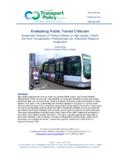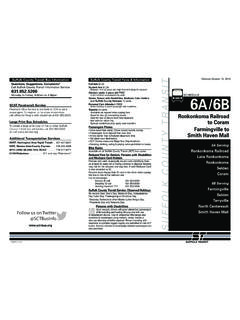Transcription of Considering Monorail Rapid Transit for North American Cities
1 Considering Monorail Rapid Transit for North American Cities Ryan R. Kennedy Table of Contents PART ONE Defining A. Monorail B. Characteristics of Monorail PART TWO Straddle Monorail Systems and A. Aerial B. Straddle Monorail C. Straddle Monorail PART THREE Monorail as Cost-effective Urban A. Monorail Capital B. Comparing Conventional Rail Systems to GENERAL Cover Picture: Seattle Alweg Monorail built in 1962.
2 Source: Seattle Times 1 INTRODUCTION Monorails have often been lumped together with flying cars as part of a na ve, cartoonish vision of the future. Despite the immense popularity monorails have had with the general public, this form of transportation has been mainly relegated to world s fairs and amusement parks. Recently, however, a number of major, Transit -grade monorails have either been built or are in the construction or planning phase. Japan is clearly the leader in the construction of new Monorail systems. The Kika-Kyushu, Chiba, Osaka and Tama monorails were launched in 1985, 1988, 1990 and 1998 respectively and have a combined line length of about 50 kilometers and over 200,000 passengers per day with over a hundred more line kilometers planned.
3 Two further monorails in Maihama(Tokyo) and Naha(Okinawa) will open within in the 2001-2003 timeframe. Kuala Lumpur, Malaysia will have its own inner-city Monorail in 2002 fully built by a company started for that purpose. A further Malaysian Monorail system is in development for the planned city, Putrajaya. In the United States, a fully automated 4 mile long Transit -grade Monorail is under construction in Las Vegas, with a 4 mile extension in the planning stage. This Monorail builds upon the success of an initial Monorail shuttle between two major hotels.
4 The initial line is privately funded and expected to reward investors with healthy returns. Finally, numerous Monorail lines are under serious consideration in Seattle. Respected studies have shown them to be very competitive with light rail and bus semi- Rapid Transit alternatives. In the course of this paper, we will examine whether these numerous recent developments are simply a fad, or whether it just took Monorail this long to earn serious respect, or whether major technical advances have improved monorails cost/benefit performance vis- -vis other forms of urban Transit ?
5 Thus, by defining monorails and their basic components, exploring recent technological innovation in Monorail Transit and actual monorails in operation we can then proceed to answer the question of whether Monorail Rapid Transit has a role to play in North American Cities , and if so, under what conditions? 2 PART ONE Defining Monorail The Monorail society defines Monorail as A single rail serving as a track for passenger or freight vehicles. In most cases rail is elevated, but monorails can also run at grade, below grade or in subway tunnels.
6 Vehicles are either suspended from or straddle a narrow guideway. Monorail vehicles are wider than the guideway that supports them. However, this rather straightforward definition is somewhat misleading as it downplays the wide range of technologies, operating principles and appearances the definition includes. A. Monorail Types Monorail (Schwebebahn) The first generally recognized Monorail was the Schwebebahn ( swaying railroad ) in Wuppertal, Germany. It is the only true mono-rail. A single steel rail is suspended from an elevated structure along which a single rail runs.
7 In this instance, the vehicle weight is both supported by the rail and guided by it. The position of the vehicle in respect to the rail is unlike traditional dual-rail systems but the basic technology by which the vehicle operates is no different from that of a railroad except that the wheels are double-flanged. Figure Schwebebahn in Wuppertal, Germany (1901) Source: Alweg Archives 3 Suspended Monorail (Safege Type) Modern versions of the Schwebebahn look similar in that the Monorail is suspended from above. However, instead of using a single rail for support and guidance, the single rail is replaced by a hollowed-out concrete or steel beam, and rubber tires are used instead of metal wheels.
8 Although this is the most common configuration, numerous combinations of steel or concrete running surfaces and rubber tires or steel wheels both singly and doubly flanged have been proposed. Figure , Japan Townliner Suspended Monorail . Source: The Monorail Society Straddle Monorail The straddle Monorail is by far the most common Monorail type that has been put into operation. It is visually probably the most pleasing type and fits into urban environments better than suspended monorails which normally need to be taller to allow for the necessary vehicular clearance under the train.
9 The straddle or sometimes Pendulum Monorail is composed of a train running on a concrete or steel guideway. The train s load bearing tires run on top of the guideway beam while the guidance tires run along the two sides of the said beam. Proposals for high speed straddle monorails that use the straddle principle use slightly different configurations but the principle is roughly the same. 4 Figure Alweg Monorail Straddle Monorail (1962). Source: The Monorail Society Cantilevered Monorail The cantilevered or side-straddle Monorail is similar in appearance and operation to the straddle Monorail .
10 However, trains going in opposite directions can share a single (but rather large) beam since cantilevered monorails are balanced by wheels on surfaces found on the sides of beam. While several companies promote such monorails, they have not seen any applications as of yet. Figure Transit cantilevered Monorail . Source: The Monorail Society 5 Maglev Monorails Most maglev (short for magnetic levitation ) trains are essentially variations on the straddle Monorail . Instead of on-board motors, the interaction of magnets on the vehicle and on the track moves the vehicle forward, while the vehicle itself is slightly levitated by other magnets.








